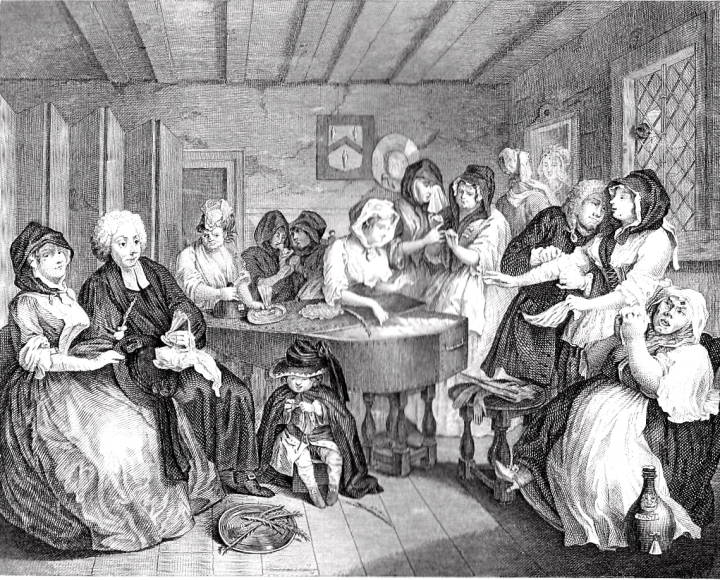Ruin has always been a part of life. Present in some form in all art forms, ruin can be seen in life and nature past, present, and future. Ruin, often thought of as being applied to old buildings and structures with ancient architecture, can also be applied to nature and humanity. For this project, ruin takes the form of a tree. This tree is picturesque, sublime, and ruined all at the same time. It is a blending and merging of the three that presents an overall ruined and bright image.
Picturesque consists in “uniting in one whole a variety of parts; and these parts can only be obtained from rough objects” (Gilpin 19). This art form is concerned with inhabiting the honest beauty of nature; an object is simply beautiful when it is unaltered to show its true flaws. The base image of the tree, the start of the trunk, is an unaltered image. It suggests the highest start of beauty and picturesque of the tree. An image in the middle to the right is also unaltered. This offers the tree an even greater beauty. Picturesque is created through the merging of the rough and ruined parts into a whole, uniting them into a coarse and rugged image. Due to the variations in light surrounding and throughout the tree, the tree looks rugged and rough, almost harsh. This picture as a whole is what represents the ruined nature of the image. Picturesque brings the images of ruggedness and beauty together to form an image that is ruined-looking through its darkness. When you take the individual images of the tree, each is beautiful and rough looking in of itself; the picturesqueness of it. However, looking at the tree overall, it is ruined. The tree is dark and shadowy looking. The sky behind offers a brighter light, but still seems to make the tree look grim. The stick-like branches are bare and jagged, suggestion of a death not far off. The bark is dark and full of holes carved out by small animals that are no longer around. The surrounding vegetation is even darker and seemingly worse off. The small dark beauties of the tree lend its way to a more subtle sublimity.
“Sublime; it is productive of the strongest emotion which the mind is capable of feeling” (Burke – Of the Sublime). When sublime is mixed with picturesque, it creates a dark, beautiful, and strong feeling. The middle of the tree creates a dark strong feeling and with the surrounding glow of the sun around the tree, and the highlights and shadows of the clouds, the tree exhibits a beautiful aurora. The tree seems to grow up into infinity, “one of the most efficient causes of the sublime” (Price, Chapter IV). The tips of the branches seem to stretch out and want to grow further, almost as if they could continue forever. The tree demonstrates the succession and uniformity that Burke discusses about sublimity. All the images complied and merged together creates this sense of uniformity and succession. From the base of the tree to the tip of the branches, all of the images align and create a series of succession to display a full, well-developed tree. Each individual image draws itself into a connection with the surrounding images. One branch merges into the next. The images are so well merged and blended together that it encompasses the uniformity that creates sublimity. Examining the tree from afar, one would hardly notice that the tree is compiled of multiple images. However, all at the same time, it is ruined. The darkness in the heart of the tree suggests ruin, the same darkness that makes it sublime. The bright, awe-inspiring light around the outside branches of the tree create a beautiful picturesque ruin.
With a theory of ruin being a balance of sublime and picturesque together, we were able to create a ruined image of a campus tree with individual elements of sublime and picturesque. Without these features, a ruined tree would not be created. Taking the characteristics of sublime and picturesque, past and present representations is what allowed for an image of ruin to be exhibited in our visual poster. The darkness, beauty, infinity, and uniformity and succession all created, merged, and developed into our image and vision of ruin.
~Heather
Burke, Edmund. The Works of the Right Honourable Edmund Burke. I. Paul Murray, Michael Punch and the PG Online Distributed Proofreading Team, 2005. eBook. <http://www.gutenberg.org/files/15043/15043-h/15043-h.htm
Gilpin, William. Three essays: on picturesque beauty; on picturesque travel; and on sketching landscape: to which is added a poem, on landscape painting. Eighteenth Century Collections Online – Text Creation Partnership, 1724-1804. Print.
Price, Sir Uvedale. On the Picturesque. University Of Pennsylvania State, Web. <http://www.english.upenn.edu/~mgamer/Etexts/price.html>.











